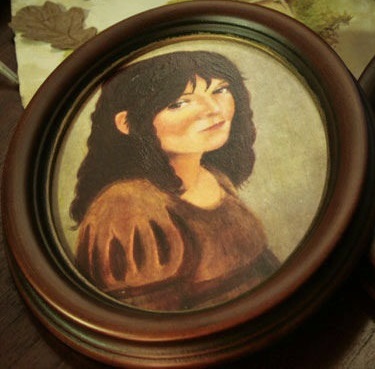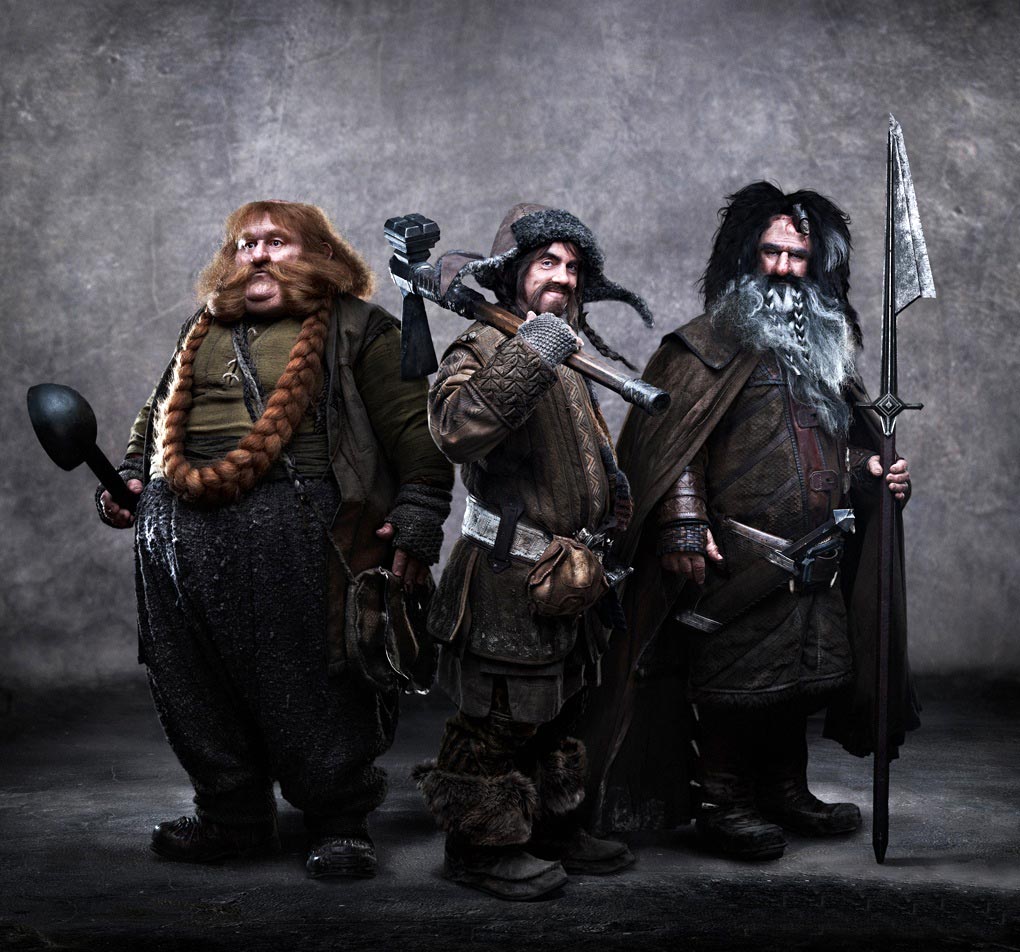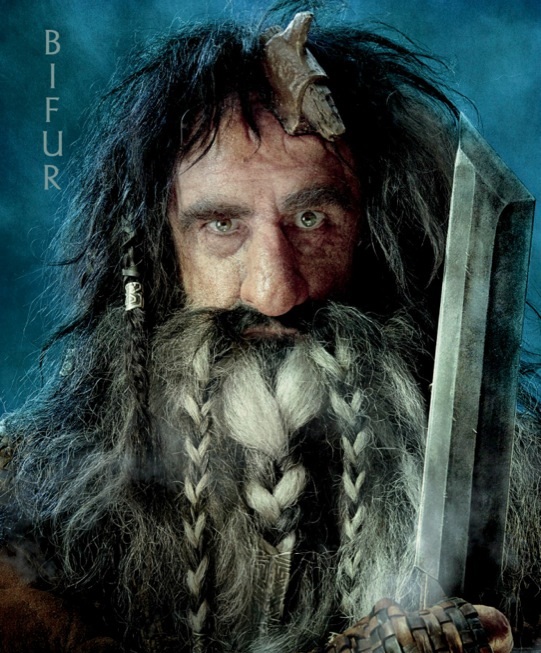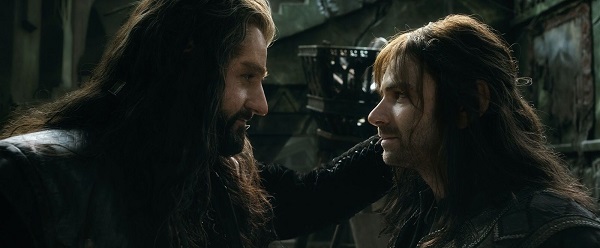It’s not exactly a secret that J.R.R. Tolkien’s The Hobbit is short on female characters. While the recent Peter Jackson films may have created new characters as well as expanding on the roles of women who go unmentioned in the book, the source material names only one woman.

“As I was saying, the mother of this hobbit—of Bilbo Baggins, that is—was the famous Belladonna Took, one of the three remarkable daughters of the Old Took, head of the hobbits who lived across The Water, the small river that ran at the foot of The Hill.”
Chapter I: An Unexpected Party, The Hobbit
You might scratch your head, remembering that Dís was the mother of Kili and Fili and the sister to Thorin. You could grab your well-loved copy of The Hobbit, confident that it mentions Lobelia Sackville-Baggins taking off with those silver spoons. The truth of the matter is that though those characters occupy those roles, they are never named until they appear in Tolkien’s The Lord of the Rings, published almost 20 years after The Hobbit.
In fact, the word “she” is used only once in The Hobbit, and it is referring to Belladonna. Three of the four uses of “her” can also be found in the same paragraph.
“Not that Belladonna Took ever had any adventures after she became Mrs. Bungo Baggins. Bungo, that was Bilbo’s father, built the most luxurious hobbit-hole for her (and partly with her money) that was to be found either under The Hill or over The Hill or across The Water, and there they remained to the end of their days. Still it is probable that Bilbo, her only son, although he looked and behaved exactly like a second edition of his solid and comfortable father, got something a bit queer in his make-up from the Took side, something that only waited for a chance to come out. ”
Chapter I: An Unexpected Party, The Hobbit
The fourth instance is personifying Night as “her” in the final song sung by the elves.
“Sing all ye joyful, now sing all together!
The wind’s in the tree-top, the wind’s in the heather;
The stars are in blossom, the moon is in flower,
And bright are the windows of Night in her tower.”Chapter XIX: The Last Stage, The Hobbit
This led me to wonder if all thirteen of the dwarves in Thorin’s company have corresponding male pronouns. In the chart below, I will list each of the dwarves (in the order they are introduced to Bilbo) and the first use of “he,” “him,” or “his” in relation to the character.

| Dwarf | First gendered pronoun | Reference |
| Dwalin | “It was a dwarf with a blue beard tucked into a golden belt, and very bright eyes under his dark-green hood.” | Chapter I: An Unexpected Party |
|
|
|
|
| Balin | “Instead there was a very old-looking dwarf on the step with a white beard and a scarlet hood; and he too hopped inside as soon as the door was open, just as if he had been invited.” | Chapter I: An Unexpected Party |
|
|
|
|
| Kili | none | n/a |
|
|
|
|
| Fili | “Fili thought he could; so when he had stared a long while to get an idea of the direction, the others brought him a rope.” | Chapter VIII: Flies and Spiders |
|
|
|
|
| Dori | “He made the hobbit scramble on his shoulders as best he could with his tied hands, and then off they all went at a run, with a clink-clink of chains, and many a stumble, since they had no hands to steady themselves with.” | Chapter IV: Over Hill and Under Hill |
|
|
|
|
| Nori | none | n/a |
|
|
|
|
| Ori | none | n/a |
|
|
|
|
| Óin | “After a while a twinkling gleam showed them returning, Oin with a small pine-torch alight in his hand, and Gloin with a bundle of others under his arm.” | Chapter XIII: Not At Home |
|
|
|
|
| Glóin | “He scowled so angrily at Gloin that the dwarf huddled back in his chair; and when Bilbo tried to open his mouth to ask a question, he turned and frowned at him and stuck out his bushy eyebrows, till Bilbo shut his mouth tight with a snap.” | Chapter I: An Unexpected Party |
|
|
|
|
| Bifur | none | n/a |
|
|
|
|
| Bofur | “It was Bofur, and he was grumbling about it, when Bilbo opened his eyes.” | Chapter VII: Queer Lodgings |
|
|
|
|
| Bombur | “‘Why, O why did I ever bring a wretched little hobbit on a treasure hunt!’ said poor Bombur, who was fat, and staggered along with the sweat dripping down his nose in his heat and terror.” | Chapter IV: Over Hill and Under Hill |
|
|
|
|
| Thorin1 | “This last belonged to Thorin, an enormously important dwarf, in fact no other than the great Thorin Oakenshield himself, who was not at all pleased at falling flat on Bilbo’s mat with Bifur, Bofur, and Bombur on top of him.” | Chapter I: An Unexpected Party |
There are four dwarves who do not have any gender-specific pronouns associated with them, so now we must move beyond pronouns and see if the text supplies any other indications.
Kili doesn’t present a challenge; as I mentioned when discussing female characters, we know that his mother is Thorin’s sister, even though she isn’t named until the Appendices of The Lord of the Rings.
“‘And who are these?’ he asked, pointing to Fili and Kili and Bilbo.
‘The sons of my father’s daughter,’ answered Thorin, ‘Fili and Kili of the race of Durin, and Mr. Baggins who has travelled with us out of the West.'”
Chapter X: A Warm Welcome, The Hobbit
There are no similar distinctions for Nori, Ori, and Bifur in The Hobbit. It could prove controversial, but I do not include the following quote as proof of gender, since “gentlemen” and “boys” are part of the simile, and beards are not limited to male dwarves2.
“You would have laughed (from a safe distance), if you had seen the dwarves sitting up in the trees with their beards dangling down, like old gentlemen gone cracked and playing at being boys.”
Chapter VI: Our of the Frying-pan Into the Fire
This means that we must turn to The Lord of the Rings for further acknowledgment. Since the fellowship discovered how Ori met his end in Moria, it’s where we can find a clue.
“‘That would be Ori’s hand,’ said Gimli, looking over the wizard’s arm. ‘He could write well and speedily, and often used the Elvish characters.'”
Chapter 5: The Bridge of Khazad-dûm
This can be corroborated in the same place that we find proof for Nori.
“Of the other companions of Thorin Oakenshield in the journey to Erebor, Ori, Nori, and Dori were also of the House of Durin, and more remote kinsmen of Thorin.”
Durin’s Folk, Appendix A III, The Lord of the Rings

Now we’ve solved for everyone except Bifur, and I have been unable to track down anything that could definitively identify Bifur’s gender. This is due to the fact that when Bifur is being described or quoted, the character is often lumped together with Bofur and Bombur, resulting in the gender-neutral pronoun of “they.”
When the relationship between the three is mentioned, it is made clear that Bofur and Bombur are brothers and Bifur is their cousin.
“There they were at last, twelve of them counting poor old Bombur, who was being propped up on either side by his cousin Bifur, and his brother Bofur.”
Chapter VIII: Flies and Spiders
“Roused by these words they were just about to creep inside the tunnel when Bifur gave a cry: ‘My cousins! Bombur and Bofur—we have forgotten them, they are down in the valley!'”
Chapter XII: Inside Information
These quotes give us no additional clues about Bifur, serving only to confirm what we knew about Bofur and Bombur.

Does the continued lack of gendered pronouns mean that J.R.R. Tolkien meant for Bifur to be any gender other than male?
It seems improbable since that would be the sort of character description that Tolkien could be counted on to supply. We cannot reliably infer anything about the author’s intentions.

Will this revelation change anything for Tolkien fans?
I doubt it. I predict that most readers will continue to assume that all of the dwarves in The Hobbit are male. It’s a hard habit to break; I had to stop myself from referring to Bifur with male pronouns while writing this, even though I knew there was no proof of gender in the text.
On the other hand, we’ve heard stories of fans changing the gender of Tolkien’s characters on their own, whether in fanfiction or their own personal headcanon. It’s easy to miss (or disregard) a tiny gendered pronoun. And in the case of Bifur, there are none to be found.
Footnotes
1. Tolkien does use “his” in regards to Thorin in the Author’s Note in The Hobbit, but since it is before the story begins, it was not categorized as the first use of a gendered pronoun to reference the character: “In this story dwarves and dwarvish are used, but only when speaking of the ancient people to whom Thorin Oakenshield and his companions belonged.”
2. “It was said by Gimli that there are few dwarf-women, probably no more than a third of the whole people. They seldom walk abroad except at great need. They are in voice and appearance, and in garb if they must go on a journey, so like to the dwarf-men that the eyes and ears of other peoples cannot tell them apart.” Durin’s Folk, Appendix A III, The Lord of the Rings




2 Comments